The Great Wisconsin Quilt Show’s 2024 Best of Show – read a Q&A with the winner
The Great Wisconsin Quilt Show is a three-day event co-presented by PBS Wisconsin and Nancy Zieman Productions that celebrates all things quilting.
05/13/25
The Great Wisconsin Quilt Show is a three-day event co-presented by PBS Wisconsin and Nancy Zieman Productions that celebrates all things quilting.
05/13/25
The Great Wisconsin Quilt Show is a three-day event co-presented by PBS Wisconsin and Nancy Zieman Productions that celebrates all things quilting. We can’t wait to bring quilters of all skill levels together in Madison Sept. 4-6, 2025!
A major highlight of this annual event is the 10-category juried and judged Quilt Contest and exhibit, and there is still time to submit entries for the 2025 Quilt Contest, due June 30.
In anticipation of this year’s Great Wisconsin Quilt Show, PBS Wisconsin spoke with Margaret E. Solomon Gunn of Gorham, Maine, who won Best of Show in 2024 with her incredible quilt, “Eyes of the Forest.”
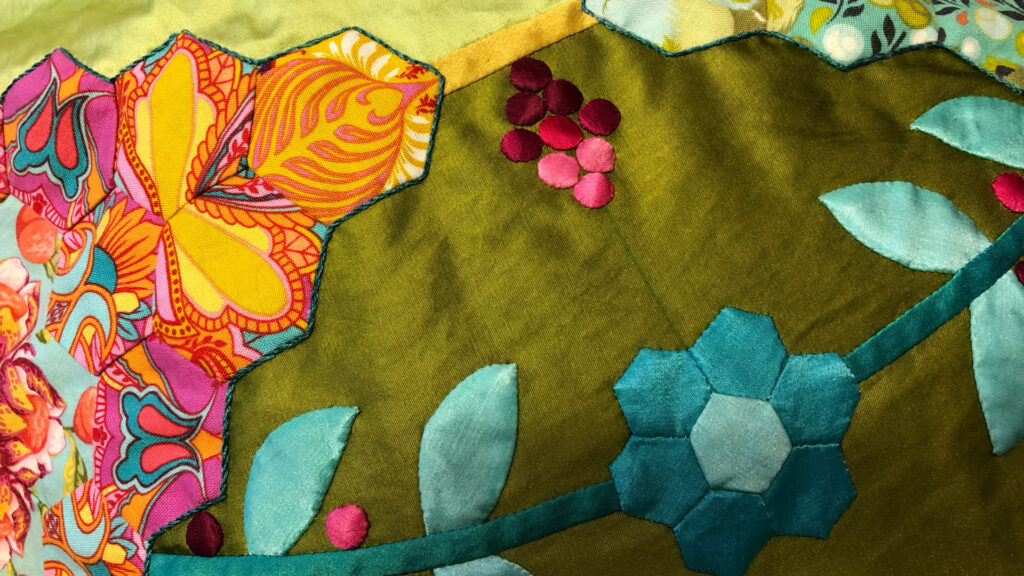
PBS Wisconsin: Can you tell us about the techniques you used to make “Eyes of the Forest”?
Margaret E. Solomon Gunn: “Eyes of the Forest” has a couple of things that are sort of trademark in many of my more recent quilts: bold, fussy-cut commercial prints and silk.
For this quilt, most of the commercial fabric comes from Tula Pink. I love the color that the prints bring to the quilt. I bought a bundle of them without a real purpose in mind; this is what became of them. In hindsight, it’s a fairly pricey way to create lots of Tula scrap — haha! — but it made for some interesting hexagons, or “hexies.”
The main techniques this quilt features are hand-pieced hexies. These are not English Paper Pieced (EPP) but another method I “created” some years ago on another quilt. I trace a clear, hexagon template where I want the hexie cut on the fabric. Then when I combine adjacent hexies, I simply run a line of running stitches by hand. This enables me to press the grouping of hexagons as desired, which happens to be not pressed fully open, as EPP tends to be. It is my years as a machine quilter that have driven me to use this method because I need to be able to “stitch in the ditch” if I want, and EPP makes this not realistic.
As far as other techniques for “Eyes,” all of the appliqué is turned-edge — I use a starch and templar method — and it is hand-stitched. There is some hand embroidery around the hexie clusters. Lastly, I try to best arrange silk in the quilt to allow quilting to show since prints are not so good at that.
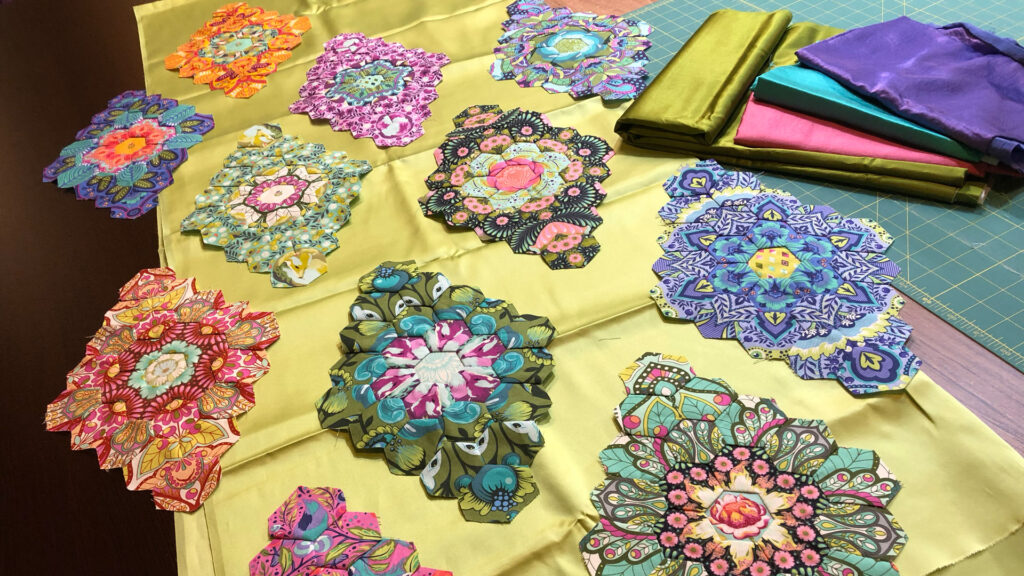
PBS Wisconsin: What inspired the design for “Eyes of the Forest”?
Solomon Gunn: It was initially just an interest in fussy cutting the Tula fabric. After I had the 18 clusters of hexagons made, then the real work of making them appear cohesive began.
I located some silk fabric in my stash that coordinated nicely and worked on the layout. At this point I did not yet have any of the vining appliqué envisioned. I was simply trying to get 18 very colorful sections arranged and located on a workable background, which there was clearly too much of. I say that kind of jokingly; I often need to be pulled away from a quilt like a comedian yanked from a stage with a cane in order to call the quilt finished.
The hexagons had another semi-dominant color, turquoise, which I wanted to introduce to the background. I had a bunch of scrap turquoise and six to eight shades of aqua fabric that I dyed and used sparingly on a quilt prior to this one. The fabric blended beautifully, and the design work of the vines and leaves began. The turquoise balanced the brightness of the tiny, roughly 1/4-inch, berries I later appliquéd onto the quilt. Color is a great thing, but it is a constant challenge to create proper balance when all of the quilt’s colors are bold choices.
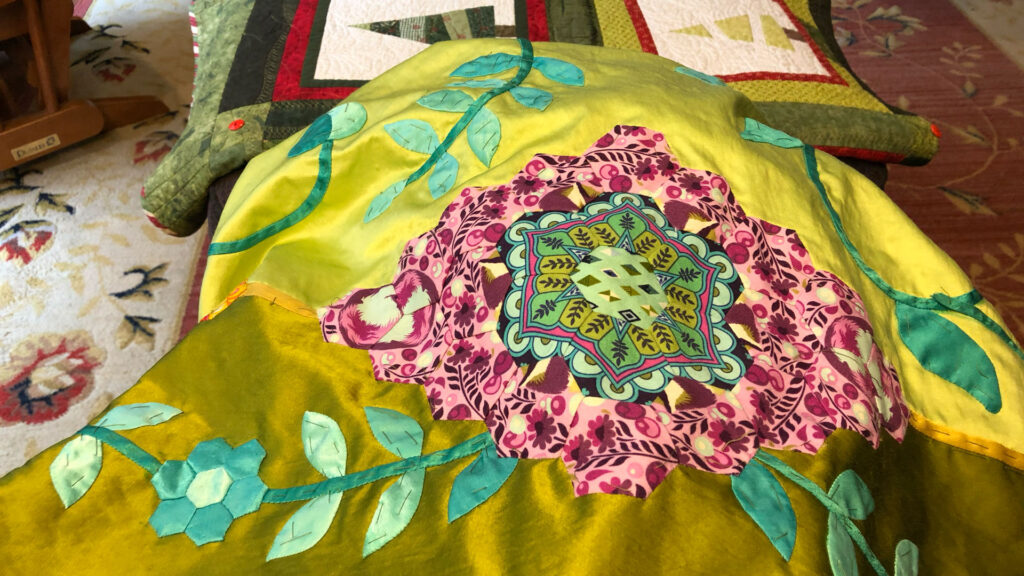
PBS Wisconsin: How long have you been quilting?
Solomon Gunn: I made my first quilt in 1988, just before graduating from college. I had sewn since I was a kid, but it was mostly clothing. Around 2006, I began making a lot of charity quilts for Project Linus as a way to pass the time when my kids napped. I got the itch in 2009 to buy a longarm quilting machine and started a business to pay it off. It was roughly at this point when my skills to design quilting as well as the quilt itself took off. Most of my early quilts and charity donations were simple piecings.
I entered my first quilt show in 2010 as a bit of an accidental afterthought. My quilt won a ribbon to my surprise. After that, I thought it might be fun to intentionally make a quilt for a show. The 2010-me could have never envisioned where she’d be in 15 years after lots of practice, drawing and learning. I credit the many client quilts I quilted for the quilting skills that I have today.
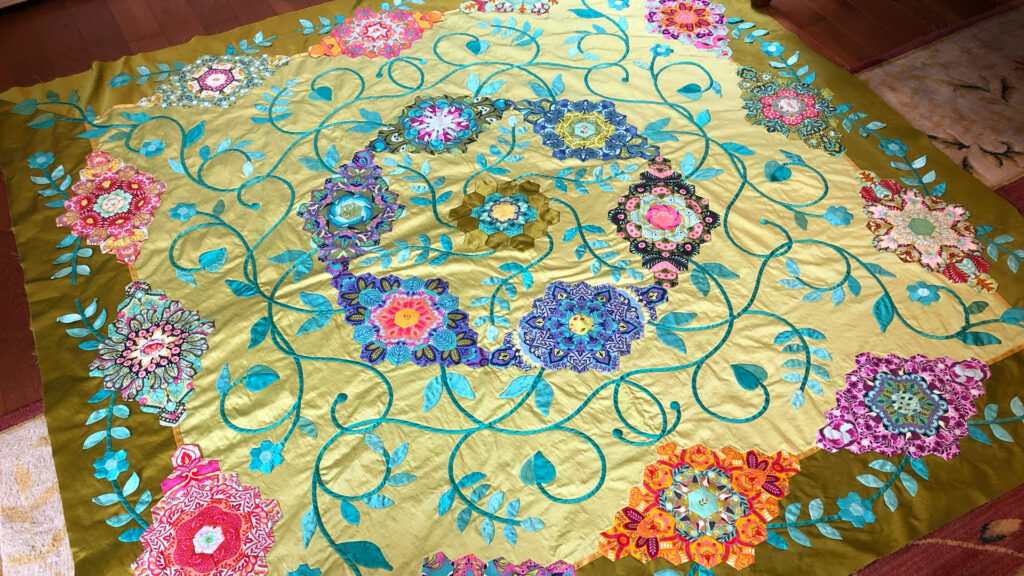
PBS Wisconsin: What is your favorite part of the quilting process?
Solomon Gunn: At any stage it can be a number of things. When I start a project, my pace is always fast; there is clearly something about starting something and feeling that adrenaline.
Generally at this point, I am all about the colors and fabrics. It’s rare for me to have a quilt fully designed right out of the gate. Sometimes I simply start by making a dozen mindless blocks from pretty fabric, then see where things go. Whereas, while I do love appliqué, it is more of a job for when I have patience and endurance. Nothing moves quickly then.
In past years, it was fairly common for me to have three quilts in progress at any given time. One of them would be already quilted and in the finishing stage of binding, embroidery, beading, painting, etc. Another quilt may be in the rotation of getting quilted.
In May 2022, I had shoulder surgery and a subsequent lengthy recovery. When I started quilting again three to four months later, I was slower, worked fewer hours a day and was mostly dedicated to getting client quilts out the door. The finish work on “Eyes” was done that fall as well, beading and binding. I didn’t do much on my own quilts for many months. Fast forward to Oct. 2024: I had the other shoulder’s rotator cuff repaired, and this happened again.
For the last three years, I have not had the ability to juggle the construction of multiple quilts. I am just now getting back into my creative mode — and hope to have a new competitive piece finished later this year.
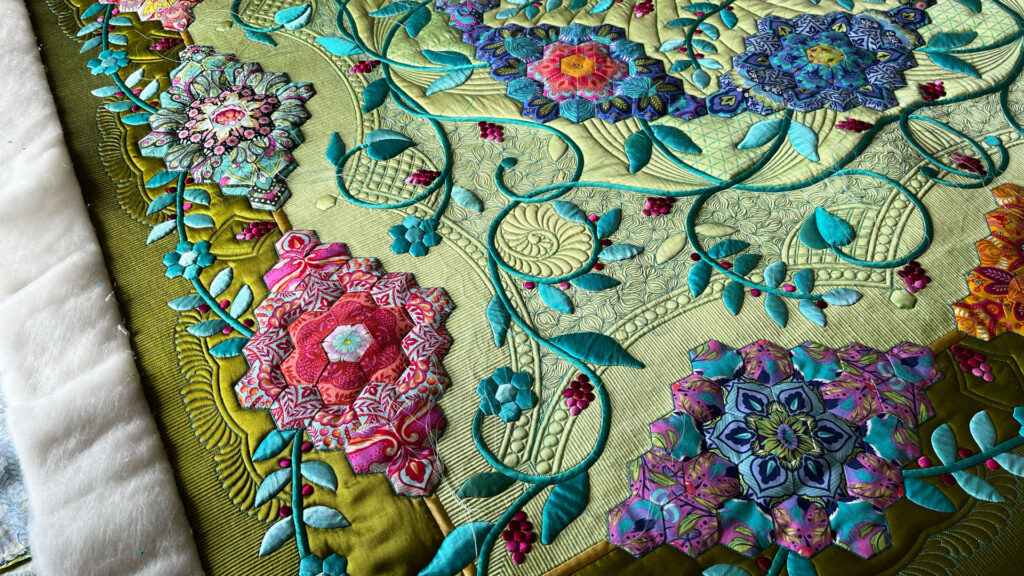
PBS Wisconsin: Is there anything else you would like to mention that we didn’t already cover?
Solomon Gunn: I will never make a quilt that does not have dedicated spaces for quilting. It is my business and therefore will always be important to me. I like quilting to appear like another layer of the design, rather than just some motifs that fit neatly into spaces of piecing.
You will notice that the quilting on “Eyes” creates a separate design amidst all of the appliqué. It requires a lot of premarking and knotting off of the thread, but the end result is worth it to me. I like to use 40 wt. thread for dominant quilting features — such as frames and feathers — and a fine, usually silk, 60-100 wt. thread for all of the crazy-dense designs. I used a very fine turquoise thread on part of the background for “Eyes” to help color the open space. From a distance it just looks like a hue of blue, but up close it is evident that the quilting has leaves and berries.
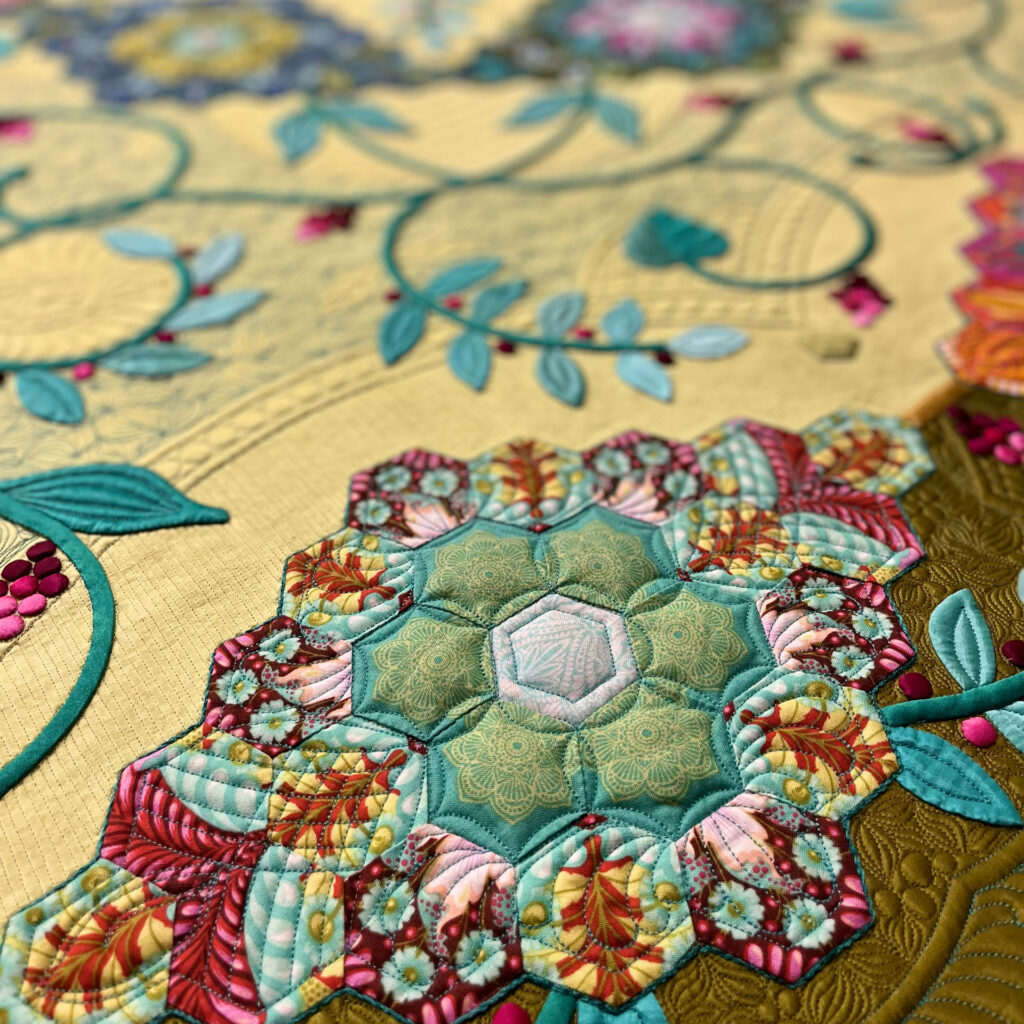
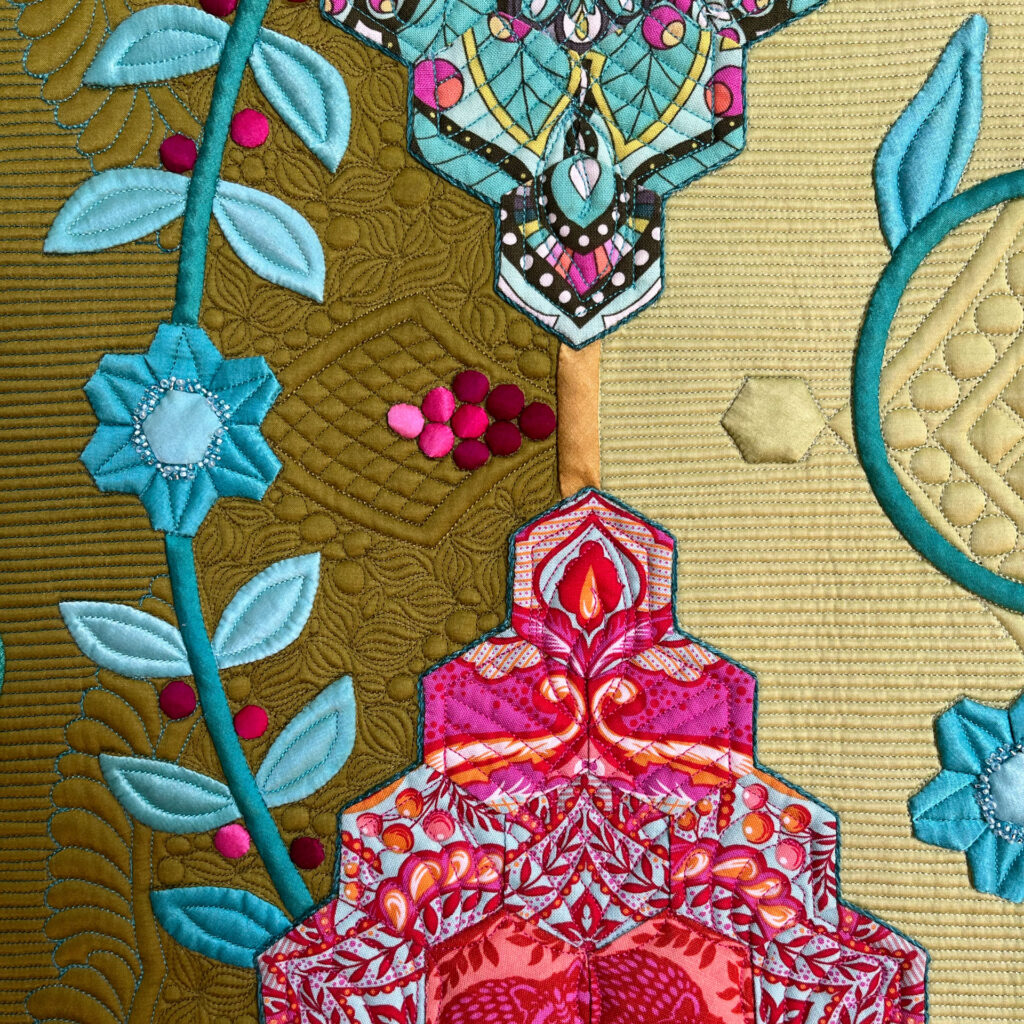
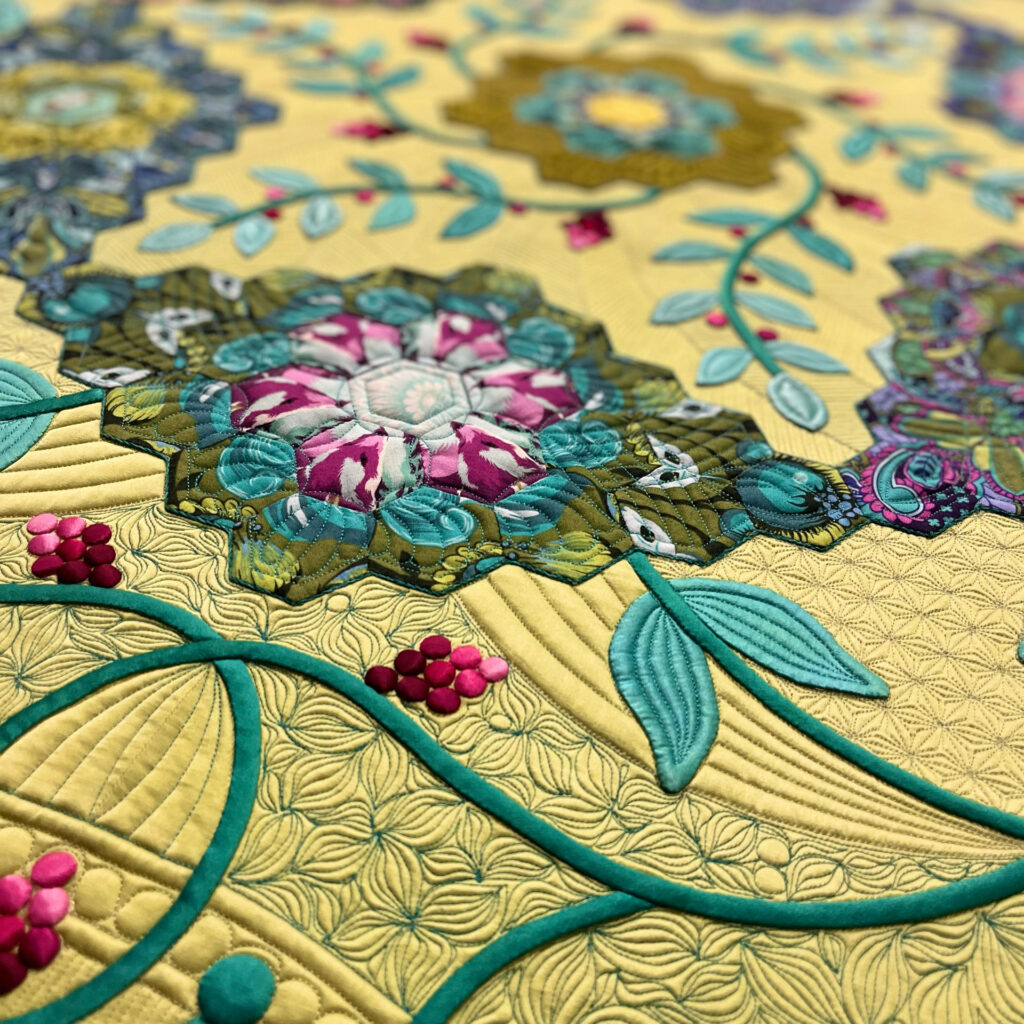
Featured image, headshot courtesy of Margaret Solomon Gunn, image of quilt credit Peg Thompson photography. All other images courtesy of Margaret Solomon Gunn.
I would love to get your thoughts, suggestions, and questions in the comments below. Thanks for sharing!
Jan Botz
Love this story about the beautiful winning quilt! It’s wonderful that PBS Wisconsin continues to offer such a significant showcase for the talented quilters in our state. They bring joy to many as we celebrate their creativity.
Tara Lovdahl
We’re proud to carry on the legacy of Nancy Zieman and showcase the incredible talent of quilters across the state — and the country!
Peggy Harper
I love seeing these spectacular quilts at shows (I live in Houston and that’s the quilt show I’ve been to most often) but I often wonder if they inspire me (which they definitely do) or intimidate me, since they do that too! Very interesting interview!
Tara Lovdahl
Thank you, Peggy! We feel inspired — and astonished! — by the talent quilters share from across the country every year!
Barb Despen
This was fascinating to read! I love hearing about her creative process and seeing up close all the wonderful details of this beautiful quilt!
Tara Lovdahl
Margaret does an incredible job explaining her quilting process!
Jo
Such an interesting read, and a gorgeous quilt!
Tara Lovdahl
Thanks for your comment, Jo! We agree — a stunning work of art!